求助PDF
{"title":"Alternative driver pathways in peripheral nerve sheath tumors – including DICER1 and/or KRAS alterations","authors":"Hsin-Yi Chang, Carla Saoud, Dianne Torrence, William Tap, Ping Chi, Cristina R Antonescu","doi":"10.1002/path.6391","DOIUrl":null,"url":null,"abstract":"<p><i>DICER1</i>-associated sarcoma is an emerging entity, defined by either somatic or germline dicer 1, ribonuclease III (<i>DICER1</i>) mutations and sharing characteristic morphologic features irrespective of the site of origin. In addition to the <i>DICER1</i> driver mutation, concurrent genomic alterations, including tumor protein 53 (<i>TP53</i>) inactivation and RAS pathway activation, are frequently detected. Tumors that morphologically resemble malignant peripheral nerve sheath tumor (MPNST) have rarely been reported among DICER1 sarcomas and often pose diagnostic challenges. This study was prompted by a case involving morphologic features of MPNST, which harbored co-existing <i>DICER1</i> and hotspot <i>KRAS</i> mutations. Hence, we investigated the incidence of these alterations in PNST from our molecular database compared to the genomic and morphologic spectrum of <i>DICER1</i>-mutant sarcomas. In total, we identified three cases diagnosed as MPNST with co-existing <i>DICER1</i>, ATRX chromatin remodeler (<i>ATRX</i>), and <i>KRAS</i> G12V/A alterations occurring in brain, cerebellopontine angle, and intra-abdominal sites. Two additional cases each of MPNSTs and neurofibromas were identified with hotspot <i>KRAS</i> mutations. All five MPNSTs lacked canonical neurofibromin 1 (<i>NF1</i>)/neurofibromin 2 (<i>NF2</i>) alterations, displaying a classic morphologic appearance with fascicular monomorphic spindle cells and followed a diverse clinical behavior. Among the 38 <i>DICER1</i>-associated sarcomas in our database, eight (21%) had secondary <i>KRAS</i> hotspot mutations, all composed of monomorphic spindle and/or round cells, including three with an MPNST-like histology. In contrast, all 10 (26%) <i>DICER1</i>-mutant sarcomas with <i>TP53</i> mutations showed a pleomorphic phenotype. The DNA-based methylation profile of our index case clustered within the group of sarcomas with <i>DICER1</i> alterations. Our results highlight a small subset of MPNST associated with <i>DICER1</i> and/or <i>KRAS</i> mutations. However, their relationship with conventional MPNST remains to be determined in larger studies. © 2025 The Pathological Society of Great Britain and Ireland.</p>","PeriodicalId":232,"journal":{"name":"The Journal of Pathology","volume":"265 3","pages":"372-384"},"PeriodicalIF":5.6000,"publicationDate":"2025-01-23","publicationTypes":"Journal Article","fieldsOfStudy":null,"isOpenAccess":false,"openAccessPdf":"","citationCount":"0","resultStr":null,"platform":"Semanticscholar","paperid":null,"PeriodicalName":"The Journal of Pathology","FirstCategoryId":"3","ListUrlMain":"https://onlinelibrary.wiley.com/doi/10.1002/path.6391","RegionNum":2,"RegionCategory":"医学","ArticlePicture":[],"TitleCN":null,"AbstractTextCN":null,"PMCID":null,"EPubDate":"","PubModel":"","JCR":"Q1","JCRName":"ONCOLOGY","Score":null,"Total":0}
引用次数: 0
引用
批量引用
Abstract
DICER1 -associated sarcoma is an emerging entity, defined by either somatic or germline dicer 1, ribonuclease III (DICER1 ) mutations and sharing characteristic morphologic features irrespective of the site of origin. In addition to the DICER1 driver mutation, concurrent genomic alterations, including tumor protein 53 (TP53 ) inactivation and RAS pathway activation, are frequently detected. Tumors that morphologically resemble malignant peripheral nerve sheath tumor (MPNST) have rarely been reported among DICER1 sarcomas and often pose diagnostic challenges. This study was prompted by a case involving morphologic features of MPNST, which harbored co-existing DICER1 and hotspot KRAS mutations. Hence, we investigated the incidence of these alterations in PNST from our molecular database compared to the genomic and morphologic spectrum of DICER1 -mutant sarcomas. In total, we identified three cases diagnosed as MPNST with co-existing DICER1 , ATRX chromatin remodeler (ATRX ), and KRAS G12V/A alterations occurring in brain, cerebellopontine angle, and intra-abdominal sites. Two additional cases each of MPNSTs and neurofibromas were identified with hotspot KRAS mutations. All five MPNSTs lacked canonical neurofibromin 1 (NF1 )/neurofibromin 2 (NF2 ) alterations, displaying a classic morphologic appearance with fascicular monomorphic spindle cells and followed a diverse clinical behavior. Among the 38 DICER1 -associated sarcomas in our database, eight (21%) had secondary KRAS hotspot mutations, all composed of monomorphic spindle and/or round cells, including three with an MPNST-like histology. In contrast, all 10 (26%) DICER1 -mutant sarcomas with TP53 mutations showed a pleomorphic phenotype. The DNA-based methylation profile of our index case clustered within the group of sarcomas with DICER1 alterations. Our results highlight a small subset of MPNST associated with DICER1 and/or KRAS mutations. However, their relationship with conventional MPNST remains to be determined in larger studies. © 2025 The Pathological Society of Great Britain and Ireland.


